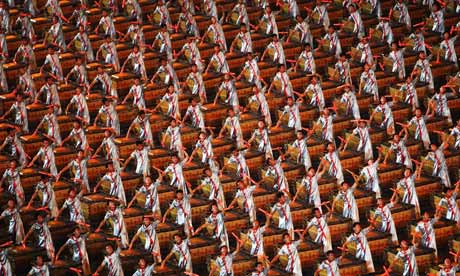 |
| Can paper percussion instruments help us keep an army of percussionists engaged when there are more players than parts? |
Schools that are large enough have negotiated this problem by scheduling a percussion class that is separate from the full band class, so that the percussionists can rehearse their parts and additional percussion ensemble music non-stop. This is obviously a great solution, as percussionists only have to risk boredom during after school rehearsals when they put their part together with the full band. But you see, while the separate class is a great solution, it doesn't avoid the problem entirely. When the percussion gets to rehearse with the full concert band, they will inevitably be bored. I did my best in rehearsals this past semester, but I, too, am guilty of allowing this to happen.
At the time I received the comment, all I knew was that you do your best to keep them busy, but thanks to Dr. Peter Boonshaft's book, "Teaching Music With Purpose", I think there may be a much better solution that actually keeps percussionists engaged.
Paper Percussion.
What is Paper Percussion?
In this case, I'm not talking about actual instruments. A google search yields results detailing how to make paper instruments for kids. That's not what we're talking about here. Peter Boonshaft describes making moch instruments, such as cutting out cymbal sized circles of cardboard, and rigging a way to hold it, so that a student who normally wouldn't be playing can shadow the cymbal player, and go through the motions. That also means they're reading music, and hopefully more engaged than they would've been.
The chapter outlines how to make paper keyboard instruments (which seems quite involved), and advocates purchasing extra practice pads for snare parts, and so on. All of the basic instruments are outlined, with step by step instructions of how to put them together.
Students then can practice percussion parts without having to be on the real instrument. At some point you can say, "Switch," to signal students to rotate, so that everyone gets to practice on the real instruments. He notes that the paper instruments do make a little noise, but not very much at all, and that it's worth it to him to keep those students engaged throughout the rehearsal. You can even watch and comment on their grip technique and stick height.
After all, we would never let a wind player sit out for an entire piece the way percussionists sometimes do.
He also suggests where to place the instruments as part of the ensemble set up. I won't go into the details, as that might risk copyright infringements, but everything you need to know is outlined. It would be a lot of work, but I'm really very interested in this.
I wonder, has anyone actually seen this in action? If so, what did you think? If not, what do you think about this idea? To me it sounds like quite a project, but like it would be well worth the effort. I'm curious to hear other's thoughts.
Thank you, as always, for reading. Until next time, take care!
Musically yours,
Mr. Cooper
PS. I have to post this code for technorati: K6AHTE9NBCNK

No comments:
Post a Comment